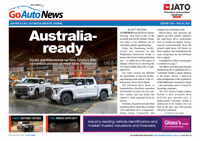Make / Model Search
News - VolvoBMW can learn from us, says VolvoGuy Burgoyne: "We want every shape to be up to date, cutting edge and modern". It’s a case of evolution not revolution for Volvo’s decade-old design language23 Jul 2004 By BRUCE NEWTON VOLVO is confident its decade-old design language still has plenty of life and it has no intention of a radical BMW-style change in the future. In fact, senior Volvo designer Guy Burgoyne believes the transition from ‘boxy but nice’ to the current heavy-shouldered design form provides lessons for BMW. Mr Burgoyne is Volvo Car Corporation studio chief designer and was responsible for the distinctive slimline console in the interior of the new compact prestige S40 and V50, a feature as original as the car’s exterior is derivative. The S40 follows on from 2003’s XC90 cross-over and 2001’s S60 sedan, both of them distinctively and recognisably Volvo designs. But the design cues of the brand, including the vertical grille, V-shape on the bonnet and those heavy shoulders, have been around since the Environmental Concept Car of 1992, which previewed 1998’s S80 luxury sedan. Mr Burgoyne said the S80 was the car which represented the Volvo equivalent of Chris Bangle’s mindset change at BMW, because it was so dramatically different to what had come before it. "We were really lagging behind," Mr Burgoyne said. "Design wasn’t one of our top requirements or features, it was all safety, all solidity and all engineering. "On the S80 we really felt that on the exterior and interior we made massive leaps in design that really brought us up to speed, or competing with where we wanted to be with the Mercedes, BMWs and Audis. "So you can say we have done the Bangle thing," Mr Burgoyne continued. "We did it with the S80, that was our big change. "BMW are in exactly the same situation we were in before the S80, they were kind of stuck and they had to do something big, they were too predictable. Nobody talked about a BMW because it was a slightly different percentage scale of a different one, either larger or smaller. "BMW are now showing a relatively consistent design language. It is controversial and it is rubbing a lot of people the wrong way, but they are being consistent. "As long as they evolve that … they can remain credible, because they are such a strong brand. But if they were to introduce a completely different radical 7 Series again, then they would be seen as being not so credible because then people would say ‘hey BMW you don’t know what you are doing, you don’t know which way you want to go’."Which, Mr Burgoyne said, was the same sort of reasoning Volvo is using to evolve rather then re-invent its design language. "I think we are still refining our core elements which we believe make us Volvo at the moment and we still believe we can refine these and modernise these for a few more steps yet," Mr Burgoyne said. "We want every shape to be up to date, cutting edge and modern. We know it has got to live for four or five years, maybe sometimes longer with facelifts in between, so we know as designers we have to be thinking about what people want within that span of time. "If we launch a vehicle and everybody thinks it is fine then by the end of its life it won’t be accepted. If we launch it and people are a little unsure then usually people will start to grow into it, or accept it, or like it over its time." Slimline design up for debateTHE future of Mr Burgoyne’s pride and joy, the slimline console that debuted in production form in S40/V50, is still being debated within the company."We have to see if this is appropriate for larger cars," Mr Burgoyne said. "It could be that we see that we would have to do some changes for larger cars to make it feel appropriately more grand."The free-floating console emerged from a design area at Volvo called the Human Machine Interface (HMI) team, which included designers, engineers, ergonomics experts, product planners and even an interaction designer. Mr Burgoyne said the team wanted to avoid both the "jumbo jet" and single controller cockpit designs that were emerging from rival prestige and luxury manufacturers. "We found this place in between where we chose what we believe to be the most commonly used functions and we made those extremely easy to use, even to the extent that we hope people don’t need to look down," he said. "That thing of not having to take your eyes off the road is extremely important to us because we are quite proud of our safety and our ethics on that. We are very much constantly thinking about the safety side of it." |
Click to shareVolvo articlesResearch Volvo Motor industry news |









Facebook Twitter Instagram